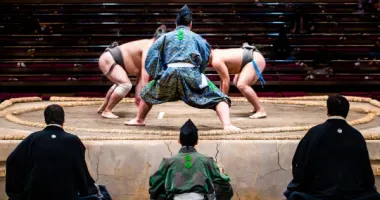Polar Science Museum Tachikawa
Polar Science Museum, Tachikawa, Tokyo 南極北極科学館 立川 東京
- First Japanese Antarctic Expedition
- Showa Base
- Taro and Jiro the Sakhalin Huskies
- Trip to the South Pole
- National Institute of Polar Research
- Tachikawa Access
by Johannes Schonherr
Japan's National Institute for Polar Research is located in Tachikawa, a thoroughly modern city on the western outskirts of Tokyo. The institute coordinates all Japanese research on the Arctic and Antarctic, including the operation of Showa Base, Japan's Antarctic research base.
Right behind the huge building block housing the institute sits the Polar Science Museum, dedicated to informing the public about the institute's activities as well as the history of Japanese polar research.
The museum's one-story building is shaped like a piece of drift ice - certainly a fitting exterior for the exhibits on display inside.
Admission is free, so just walk in. The interior of the museum is much bigger than the exterior suggests. It's crammed with exhibits and information displays, trying to cover almost every conceivable aspect of Japanese Antarctic research.
There are a few displays on Arctic research too but the Antarctic is clearly the focus here.
The exhibits are grouped by topic. They don't lend themselves easily to a step-by-step understanding of the history of Japanese Antarctic research. All the milestones of Japanese Antarctic research are documented, though, it just takes a bit to connect the various dots.

Polar Science Museum, Tachikawa, Tokyo

Interior, Polar Science Museum, Tachikawa, Tokyo
First Japanese Antarctic Expedition
Japan's first Antarctic expedition took place from 1910 to 1912. It was led by Lieutenant Nobu Shirase with the aim of exploring the King Edward VII Peninsula.
After initial difficulties caused by the extreme weather of the region, a group of Shirase expedition members were the first humans to actually set foot on the peninsula. During the course of their exploration, the Shirase expedition accidentally encountered Roald Amundson's party returning from its conquest of the South Pole.

Model of Showa Base, Polar Science Museum, Tachikawa, Tokyo

Poster for Chef of South Polar
Showa Base
Showa Base, the first Japanese research base in the Antarctic, was opened in 1957. In Japanese English-language publications, the name of base is often spelled as Syowa Base - the National Institute for Polar Research for example prefers that spelling. In any case, the name refers to the Showa Period (1926-1989) when Emperor Hirohito (aka Showa) was the emperor of Japan.
With the establishment of Showa Base, Japanese Antarctic research really took shape. By now, several smaller research stations have also been established.
A model of Showa Base is on display at the museum. Behind it, a satellite live stream shows the current going-ons at the station. In December 2017, a large construction project was under way at the base, covered by the live stream relaying one image per minute.
A film tip here if you want to learn more about life on a Japanese Antarctic research station in an entertaining way: the 2009 film Chef of South Polar (Nankyoku Ryorinin, 南極料理人) depicts the daily joys and struggles on the small Japanese Antarctic base Dome Fuji (established in 1995), focusing on the crucial importance of the base's cook on the explorers' mood. The film is based on the writings of Jun Nishimura, a cook from Hokkaido who served several seasons as a cook on Dome Fuji Station. The film is available on Blue-ray and DVD in Japanese. Unfortunately, there is currently no English subtitled version available.

Model of the Antarctic without ice cap, Polar Science Museum, Tachikawa

Stuffed seals at the Polar Science Museum, Tachikawa
Taro and Jiro: the Sakhalin Huskies
One of the most famous stories of the early years of Showa Base was the story of Taro and Jiro, two Sakhalin huskies. In February 1958, the transition from the Antarctic summer team to the winter team didn't work out because of extreme weather.
The summer team was flown out in an emergency rescue operation but the 15 Sakhalin huskies serving as sledge dogs had to be left behind.
Two of the huskies, Taro and Jiro, survived the Antarctic winter months on their own, hunting seals and penguin. After the two dogs greeted their rescuers the following spring, they became national heroes in Japan.
The Polar Science Museum documents the fate of all Sakhalin huskies in service from 1956 to 1958, with, of course, a special focus on Taro and Jiro.
A monument to Taro and Jiro was erected in Wakkanai, Hokkaido, the city where they were raised and trained.
The 1983 film Antarctica (Nankyoku Monogatari, 南極物語) tells their story. (DVD and Blue-ray, Japanese release without subtitles. Vintage English-language VHS copies are available but rather pricey.)

Japanese Antarctic expedition vehicle from 1968, Polar Science Museum, Tachikawa, Tokyo
Trip to the South Pole
In the Antarctic summer season of 1968-1969, a small fleet of Japanese tank tread explorer vehicles made a trip all the way to the South Pole and back to Showa Base.
One of the vehicles used is exhibited at the Polar Science Museum. The vehicle can be entered though unfortunately, it is not possible to sit down in the driver's seat.

Inside the 1968 expedition vehicle, Polar Science Museum, Tachikawa, Tokyo

Live stream from Showa Base at the Polar Science Museum, December 2017, Tachikawa, Tokyo
National Institute of Polar Research
Although establishing a National Institute for Polar Research was already proposed in 1961, it took all the years up to 1973 for the institute to get properly established. The institute has been the central agency for all Japanese polar research ever since.
This research includes expeditions searching for meteorites in Antarctica (several such meteorites are on display at the museum), as well as drilling for samples of ancient Antarctic ice (an impressive drilling device is on display as is a chunk of current Antarctic ice in a freezer box).
Animal research is done both in the Arctic and Antarctic. Stuffed seals, penguins and other polar animals are on display.

A meteorite found in Antarctica, Polar Science Museum, Tachikawa
Multiple video screens show documentary footage of historic exhibitions as well as on current research.
If you have a deeper interest in the polar regions and especially Antarctica, you can spend hours in the museum, learning a lot about the research being done.
That's provided your Japanese is up to the task. Most exhibits come with explanations in Japanese only though some also carry English information. All videos are in Japanese.
For those with a rather cursory interest in polar research, many of the exhibits are easy to understand even without any ability to read Japanese. There is plenty offered for the eye.
If you have a deeper interest in the subject, though, and feel that your Japanese might not serve you well enough, you should visit with a Japanese friend who can translate.
Opening times: 10am to 5pm, closed on Sundays, Mondays, public holidays including the New Year holidays.
Address: Midori-cho 10-3, Tachikawa City, Tokyo
Tel: 042 512 0910
Admission: free
Website in English www.nipr.ac.jp/english/science-museum/index.html
Tachikawa Access
JR Chuo Main Line from Tokyo Station (40 minutes) or Shinjuku Station (25 minutes) to Tachikawa Station.
Book Hotel Accommodation in Tokyo
Books on Japan
The Polar Science Museum (南極北極科学館) in Tachikawa, Tokyo is dedicated to informing the public about the Japanese polar research and the activities of the National Institute for Polar Research.





























